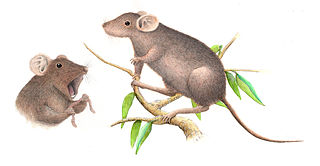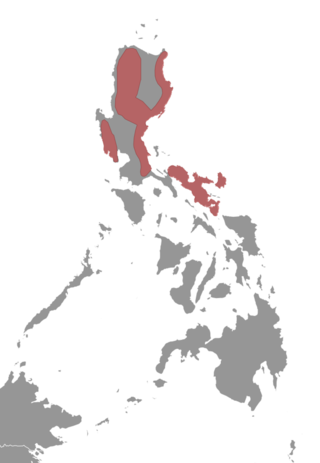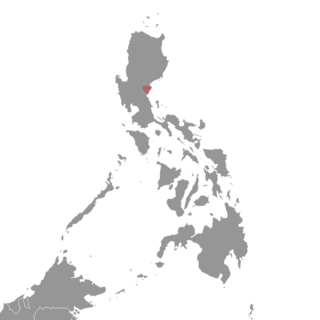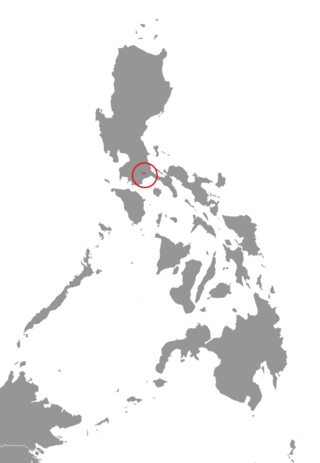
Apomys, commonly known as earthworm mice, is a genus of rodent endemic to the Philippines. Mice belonging to this genus are generally called Philippine forest mice and can be found on most islands of the Philippines except in Palawan, the Sulu Archipelago, and the Batanes and Babuyan group of islands.

The Camiguin forest mouse is a forest mouse endemic to the island of Camiguin in the southern Philippines. It has large ears and eyes, a long tail and rusty-brown fur, and it feeds mostly on insects and seeds. This description is based on mice captured during a biological survey conducted in 1994 and 1995 high on the steep slopes of one of the island's volcanoes.

The Luzon Cordillera forest mouse is a species of rodent in the family Muridae found in the Philippines.

The Luzon montane forest mouse is a species of rodent in the family Muridae, from the genus Apomys. It occurs only in the Philippines, where it has been found on the large northern island Luzon. It is most closely related to the large Mindoro forest mouse, which occurs on Mindoro. There may be another related species in the Sierra Madre, but this species is yet undescribed. The Luzon montane forest mouse is a relatively large, ground-dwelling rat with a tail that is quite short for its genus.

The large Mindoro forest mouse is a species of rodent in the family Muridae, from the genus Apomys. It is found only in the Philippines. Its natural habitat is subtropical or tropical moist montane forests. It is a large mouse with large feet, a long tail and an elongated snout which is morphologically unique within its genus. It is covered in soft fur which is mostly dark brown in colour. Its closest relative is thought to be the Luzon montane forest mouse, based on genetic and morphological similarities.

The small Luzon forest mouse is a species of rodent in the family Muridae. It is found only in the Philippines.

The least forest mouse is a species of rodent in the family Muridae. It is found only in the Philippines.

The long-nosed Luzon forest mouse, also known as the Pinatubo volcano mouse, is a species of rodent in the family Muridae.

The Sierra Madre is the longest mountain range in the Philippines. Spanning over 540 kilometers (340 mi), it runs from the province of Cagayan down to the province of Quezon in a north–south direction on the eastern portion of Luzon, the largest island of the archipelago. It is bordered by the Pacific Ocean to the east, Cagayan Valley to the northwest, Central Luzon to the midwest, and Calabarzon to the southwest. Some communities east of the mountain range, along the coast, are less developed and so remote that they could only be accessed by taking a plane or a boat.
Danilo S. Balete, also known as Danny Balete, was a Filipino zoologist and biologist. His is known for his work on the Philippines' endemic mammal species. He pursued the question of what determines species diversity. The research by Balete and his team overturned previously held notions that diversity decreased in mountainous regions, showing that harsh environments could generate, rather than suppress, species diversity.

The Luzon giant forest mouse is a forest mouse endemic to Luzon, Philippines.

The Luzon Aurora forest mouse is a forest mouse endemic to Aurora in Luzon, Philippines.

The Mount Banahaw forest mouse is a forest mouse endemic to the Mount Banahaw area in the Philippines.

The Mount Tapulao forest mouse is a forest mouse endemic to the Mount Tapulao area in the Philippines. It is named after the American zoologist Barbara Elaine Russell Brown.

The Sierra Madre forest mouse is a forest mouse endemic to the Sierra Madre Range of eastern Luzon, Philippines.

The Mount Mingan forest mouse is a forest mouse endemic to Mount Mingan in Luzon, Philippines.

The Mount Irid forest mouse is a forest mouse endemic to Mount Irid in Luzon, Philippines.

The Lubang forest mouse is a forest mouse endemic to Lubang Island in the Philippines.

Hydromyini is a very large, diverse tribe of muroid rodents in the subfamily Murinae. They are the dominant native rodents in Australasia and one of only two native rodent groups there, the other being the R. fuscipes group of the genus Rattus in the tribe Rattini. They are also found in parts of Southeast Asia.

















